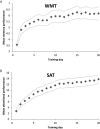Dissociable effects of attention vs working memory training on cognitive performance and everyday functioning following fronto-parietal strokes
- PMID: 30569816
- PMCID: PMC7266670
- DOI: 10.1080/09602011.2018.1554534
Dissociable effects of attention vs working memory training on cognitive performance and everyday functioning following fronto-parietal strokes
Abstract
Difficulties with attention are common following stroke, particularly in patients with frontal and parietal damage, and are associated with poor outcome. Home-based online cognitive training may have the potential to provide an efficient and effective way to improve attentional functions in such patients. Little work has been carried out to assess the efficacy of this approach in stroke patients, and the lack of studies with active control conditions and rigorous evaluations of cognitive functioning pre and post-training means understanding is limited as to whether and how such interventions may be effective. Here, in a feasibility pilot study, we compare the effects of 20 days of cognitive training using either novel Selective Attention Training (SAT) or commercial Working Memory Training (WMT) programme, versus a waitlist control on a range of attentional and working memory tasks. We demonstrate separable effects of each training condition, with SAT leading to improvements in spatial and non-spatial aspects of attention and WMT leading to improvements on closely related working memory tasks. In addition, both training groups reported improvements in everyday functioning, which were associated with improvements in attention, suggesting that improving attention may be of particular importance in maximising functional improvements in this patient group.
Keywords: Attention; Cognitive training; Stroke; Working memory.
Figures





References
-
- Alloway, T. P. (2007). Automated working memory assessment. London: Pearson Assessment.
-
- Anderson, B., Mennemeier, M., & Chatterjee, A. (2000). Variability not ability: Another basis for performance decrements in neglect. Neuropsychologia, 38(6), 785–796. - PubMed
-
- Barker-Collo, S., Feigin, V. L., Parag, V., & Lawes, C. M. M. (2010). Aukland stroke outcomes study part 2: Cognition and functional outcomes 5 years poststroke. Neurology, 75, 1608–1618. - PubMed
Publication types
MeSH terms
Grants and funding
LinkOut - more resources
Full Text Sources
Medical
Research Materials
